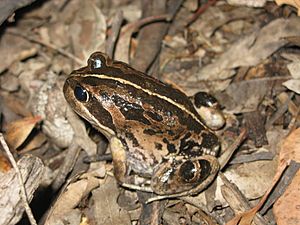Limnodynastes dorsalis facts for kids
Quick facts for kids Limnodynastes dorsalis
|
|
|---|---|
| Scientific classification |
The Limnodynastes dorsalis is a type of frog that belongs to the family called Limnodynastidae. People often call this frog by other names like the western banjo frog, pobblebonk, sand frog, or bullfrog. It is a special kind of amphibian that is only found in Western Australia.
Contents
About the Western Banjo Frog
This frog is quite large for its family, Myobatrachidae. It has strong legs and a head shaped like a triangle. Female frogs can grow up to 87 mm long, while males are a bit smaller, reaching about 75 mm.
What it Looks Like
The western banjo frog is usually grey or brownish-olive in color. It has dark or black blotches and swirly patterns on its skin. These markings are bigger on its back and smaller on its legs and face. A wide, dark stripe goes across its eye and down to its front leg.
Its belly is pale, either white or yellowish, and feels smooth. The top of its body is also smooth, but sometimes it can have small bumps. A large, oval bump called a tibial gland is found on the upper part of its back leg. Its toes have very little webbing, and the second toe might be a bit longer than the first. The area around its groin is reddish to bright red. This red color helps tell it apart from the similar Limnodynastes dumerilii, which is known as the eastern banjo frog.
Sounds and Reproduction
Male western banjo frogs make a loud 'plonk' or 'bonk' sound. They usually do this when they are almost underwater or hidden in thick plants. This sound is very much like plucking a banjo string, which is why the frog has its common names. When many frogs call together, the sound is very loud and well-known in the areas where they live.
Life Cycle
After mating, the frogs lay their eggs, which are called spawn. The spawn forms a large mass that floats on the surface of still or slow-moving water. It often floats around grasses or other plants that help keep it in place.
What They Eat
The western banjo frog mainly eats insects and worms. However, it will eat almost anything small enough that it can catch.
Where the Western Banjo Frog Lives
This frog was first described in 1841. There are twelve different types of Limnodynastes frogs found in Australia. The Limnodynastes dorsalis is the only one found in the southwest part of the country. This species lives in an area surrounded by dry regions. It became isolated there because of past climate changes across Australia.
Habitat and Distribution
The western banjo frog lives all over Southwest Australia. This region has many different kinds of plants and animals and a climate similar to the Mediterranean. The frog prefers to live near water that stays there all the time. It is only found in Western Australia. Its range stretches from east of Kalbarri in the north, east to the Great Australian Bight, and inland into dry areas.
Status and Conservation
The population of Limnodynastes dorsalis has been affected by changes in how land is used. However, it seems to be safe from major threats. In fact, building dams in rural areas or creating water features in towns has made new homes for these frogs.
The species is common throughout the southwest of the state. Many of them can be found near creeks and rivers. They usually hide in thick plants in these places. During the dry season, they sometimes live in burrows underground.
See also
 In Spanish: Limnodynastes dorsalis para niños
In Spanish: Limnodynastes dorsalis para niños


